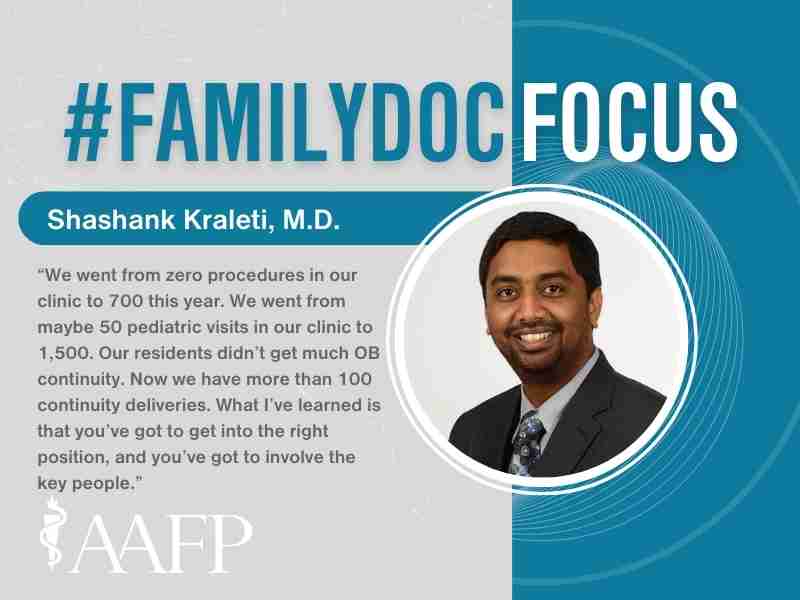FP Who Expanded Resident Opportunities Earns ACGME Honor
October 25, 2022, 11:25 a.m. David Mitchell — When Shashank Kraleti, M.D., was a resident at Little Rock Family Medicine, he treated pediatric patients during rotations at nearby Arkansas Children’s Hospital, but he did not see children in the program’s primary care clinic at University of Arkansas for Medical Sciences.

When he became the program’s director, he wanted a better training experience for residents.
“They might go to Children’s Hospital in August of one year and May of next year, but they missed everything in the winter,” he said, “so their training was inferior. Now our residents go to the hospital throughout the year, and they see kids in our clinic throughout the year. I had tried to change that as a first-year resident in my program, but I was unsuccessful. I tried it as a chief resident and an associate program director. I was only successful when I tried it again as a program director. Persistence pays.”
Kraleti knows about persistence and the value of continuity of care. A graduate of Andhra Medical College in India, he moved to the United States and spent two years shadowing U.S. physicians and taking the steps needed to achieve Educational Commission for Foreign Medical Graduates certification.
He actually found his path to family medicine during an observership in internal medicine when an attending’s recommendation for comfort care clashed with the wishes of a patient and family.
“I realize now that I was completely out of line,” Kraleti said with a laugh, “but I remember this even 15 years later. I argued with the attending for the patient and family because they wanted something different from what was being proposed. I convinced the attending, and the patient was discharged at home on hospice. But I never got to find out what happened, and that was huge for me. When I had conversations with my mentors, we realized that I needed to go into family medicine. I needed to have those relationships.”
Kraleti, who has been Little Rock’s program director since 2016, wanted the same for his residents. Thus, a program that had not offered continuity of care for obstetric patients or procedures in the primary care setting was soon offering both — as well as pediatric care.
“We went from zero procedures in our clinic to 700 this year,” he said. “We went from maybe 50 pediatric visits in our clinic to 1,500. Our residents didn’t get much OB continuity. Now we have more than 100 continuity deliveries.”
Kraleti said Little Rock was an “older, deep-rooted” program, and change was not easy.
“What I’ve learned is that you’ve got to get into the right position, and you’ve got to involve the key people,” said Kraleti, who serves on more than 20 university and department committees and is a member of the Arkansas AFP Board of Directors.
Kraleti also serves as medical director in the UAMS Division of Community Health and Education, vice-chair for clinical affairs, associate professor and chair in family and preventive medicine, service line director for primary care and population health, and is a clinical informaticist.
A research curriculum developed by Kraleti has resulted in 20 journal publications by the program’s residents and a similar number of national presentations in the past five years.
His next project is developing interdisciplinary didactics.
“It is based on how the residents learn to provide care for patients,” he said. “Every clinic, every setting has interdisciplinary teams, and my goal is to mimic that in their training as well because they need to learn how they’re going to practice.”
Kraleti was recently named a recipient of the Parker J. Palmer Courage to Teach Award, which recognizes program directors who foster innovation and improvement in their programs and serve as exemplary role models. He will receive the award in February at the Accreditation Council for Graduate Medical Education’s annual meeting.
Kraleti became the medical school’s service line director for primary care and population health earlier this year, giving him oversight of more than 20 ambulatory clinics across the state. The network includes 13 residency programs, including three rural programs set to open in 2024. His responsibilities include clinic operations, quality metrics, community health, and recruitment and retention of staff in family medicine, internal medicine and geriatrics.
One of his first steps has been to improve communication between sites, including forming an executive committee with representation from across the network. The system also is working to enhance care given outside of its clinics and hospital, including telemedicine, mobile clinics and a house call program.
“There are two pieces to population health, one of which is quality and value-based care for our empaneled patients,” he said. “But then there’s the piece which is out in the community, going to the people who don’t otherwise come into our system, figuring out their needs and helping them.”
The health system has also launched an initiative to address the social determinants of health.
“For most of our patients with poorly controlled diabetes or uncontrolled hypertension, we don’t have their social determinants information,” he said. “Without that information, we’re just shooting in the dark.”
An effort is underway to capture that information for every patient with a chronic condition, as well as a project to create a list of resources to address patients’ social needs.
“If we learn that out of the 6,000 patients, 1,000 of them have transportation issues, then we already have a list of resources by county,” he said. “If a patient is living in this county, what resources are available for issues like transportation or food insecurity so we can address those gaps as we continue to manage their chronic diseases.”